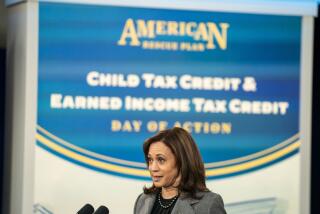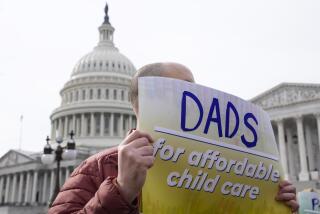Polarization Politics Seen as Key Obstacle to Welfare Proposal : Reform: Despite gaining consensus for his plan outside capital, Clinton faces stiff test in trying to overcome assaults from liberals, conservatives.
- Share via
WASHINGTON — The welfare reform plan that President Clinton released Tuesday sits squarely in the center of public opinion on this historically divisive issue, according to several recent polls. But that may not be enough to guarantee the proposal a majority in Congress.
Indeed, the coming debate over welfare reform--which will remain muted until Congress finishes action on health care--is likely to illuminate the difficulties of translating a consensus outside the capital into a consensus among the interest groups, elected officials and political strategists who shape the legislative process inside the Washington Beltway.
Within hours of its release, Clinton’s plan was under intense assault from liberals as too harsh and from conservatives as too soft. “This is a pretty conservative plan,” said Roberta M. Ikemi, a staff attorney at the California Women’s Law Center in Los Angeles. “I have some grave worries about whether this is a disguised way of punishing women.”
Meanwhile, William J. Bennett, education secretary under Ronald Reagan and an unimpeachable conservative, dismissed the plan as “a joke, a half fraud . . . , marginal tinkering.” Only the rare voice in the middle praised the program: Will Marshall, president of the Progressive Policy Institute, a centrist think tank, hailed it as “radical, yet constructive change.”
*
Overcoming these impulses toward polarization will make welfare reform the sternest test of Clinton’s capacity--and willingness--to forge a new centrist coalition for change that transcends what he has called “the brain-dead politics in both parties.”
“The problem is you now go into a congressional process that is driven by political factions . . . that are not connected to what is happening in the country,” said Stanley B. Greenberg, Clinton’s pollster.
Over the last 30 years, few issues in American politics have been more divisive than welfare. Conservatives, like Reagan, have routinely disparaged recipients as greedy, indolent “welfare queens,” while many liberals have reflexively labeled all critics of the system as uncaring and racist.
The premise of Clinton’s presidential campaign--influenced heavily by ideas in journalist E. J. Dionne’s book, “Why Americans Hate Politics”--was that the “false choices” in that ritualistic debate alienated most Americans. The promise of Clinton’s approach to welfare was that by fusing traditionally liberal ideas of increasing spending on education and training with the conservative demand for work (embodied in his call for a two-year limit on benefits) he would build a new consensus for reform.
In fact, that consensus already glimmers from surveys of public opinion. Clinton’s proposed two-year limit--coupled with a promise of public service employment if private jobs cannot be found--won support from an overwhelming 90% of those polled in an April Los Angeles Times survey. Opinion varied hardly at all by race or party affiliation.
*
Other core ideas in Clinton’s plan also draw substantial majorities. Two-thirds of those surveyed in The Times Poll supported his proposal to require teen-agers receiving welfare to live with their parents or another responsible adult; two-thirds also supported denying additional benefits to women who have children while already on welfare, as Clinton’s plan would allow states to do. Another recent poll found more than 90% of Americans back Clinton’s call for cracking down on absent parents who owe child support.
By contrast, in The Times Poll just one in four of those surveyed supported the idea that has rallied conservatives: cutting off all welfare benefits for women who bear children out-of-wedlock.
But it remains uncertain that the political system can deliver change that reflects the broad consensus in public opinion. If there is any lesson in Clinton’s first 17 months in office, it is that Washington actively resists consensus. On issues from health care to deficit reduction to crime, polarization has appeared to be the oxygen of the political system--equally indispensable as an organizing tool for liberals and conservatives alike.
To many observers, Clinton has exacerbated this problem by vacillating in his legislative and political strategy. On the crime bill now moving toward conclusion and the North American Free Trade Agreement, Clinton did seek bipartisan centrist coalitions. But on his top priorities, last year’s economic plan and now his health care reform, his proposals have been aimed almost entirely at Democrats.
“There is a conceptual Rubicon that this Administration hasn’t yet crossed toward a strategy that builds coalitions across the center of the spectrum rather than from the left in,” said Marshall.
That hesitancy is reflected in some compromises in the welfare plan, critics said. Republicans, for instance, complained that Clinton has undermined his two years-and-out pledge by allowing welfare recipients to remain on public employment indefinitely if they cannot find private sector work. “I think people want some real time limits here,” said Rep. Rick Santorum (R-Pa.), who led a task force that produced the principal GOP welfare proposal.
And Republicans, along with some moderate Democrats, complained that, by imposing the new two-year work requirement only on recipients born after 1971, Clinton has eviscerated his promise to “end welfare as we know it.” Intended partly to defuse opposition on the left, that cautious approach means that only about two-thirds of the caseload will face the work requirement by 2004, the Administration estimates.
These, however, are the kind of tactical differences that legislators are paid to resolve, and Santorum acknowledged that the Clinton work proposals could be the basis for a center-right congressional agreement. “There are problems there,” he said, “but they are not insurmountable problems as far as we’re concerned.”
Paying for the plan will pose another significant hurdle. Clinton’s call for funding the reform mostly through cuts in other social programs reinforces resistance on the left. But Clinton’s biggest problem may be that, by delaying the plan’s introduction for so long, he allowed the centrifugal forces in the welfare debate to gain strength. “They lost a lot of momentum,” said Rep. Dave McCurdy (D-Okla.).
While moderate Democrats led by McCurdy have put forward a plan similar to Clinton’s, congressional liberals have camped out in staunch opposition to his two-year limit and “family cap” provisions.
Republicans likewise are fractured on the issue. Last fall almost all House Republicans signed onto Santorum’s bill--which approaches Clinton’s in many respects. But that support has eroded under a withering conservative counterattack which contends that the legislation costs too much, does too little to deter illegitimate births and does not draw a sharp enough contrast with Clinton.
Clinton’s plan has positioned him firmly in the center of the welfare debate--ordinarily the most prized real estate in politics. But in the perplexing geography of welfare reform, the center may prove too narrow a strip of ground to control the battle. The test for Clinton now is to demonstrate that his promise of ending the “false choice” of political polarization on welfare is not itself a false hope.
More to Read
Get the L.A. Times Politics newsletter
Deeply reported insights into legislation, politics and policy from Sacramento, Washington and beyond. In your inbox three times per week.
You may occasionally receive promotional content from the Los Angeles Times.










